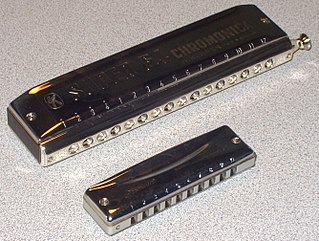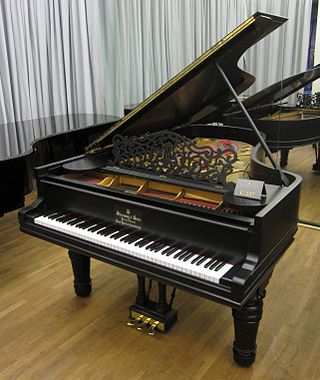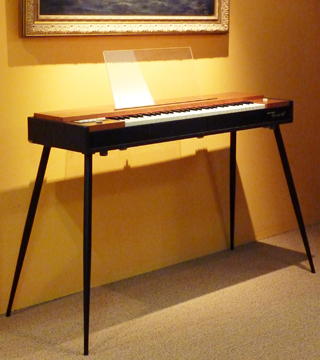
Accordions are a family of box-shaped musical instruments of the bellows-driven free reed aerophone type. The essential characteristic of the accordion is to combine in one instrument a melody section, also called the diskant, usually on the right-hand keyboard, with an accompaniment or Basso continuo functionality on the left-hand. The musician normally plays the melody on buttons or keys on the right-hand side, and the accompaniment on bass or pre-set chord buttons on the left-hand side. A person who plays the accordion is called an accordionist.

The hammered dulcimer is a percussion-stringed instrument which consists of strings typically stretched over a trapezoidal resonant sound board. The hammered dulcimer is set before the musician, who in more traditional styles may sit cross-legged on the floor, or in a more modern style may stand or sit at a wooden support with legs. The player holds a small spoon-shaped mallet hammer in each hand to strike the strings. The Graeco-Roman word dulcimer derives from the Latin dulcis (sweet) and the Greek melos (song). The dulcimer, in which the strings are beaten with small hammers, originated from the psaltery, in which the strings are plucked.

The harmonica, also known as a French harp or mouth organ, is a free reed wind instrument used worldwide in many musical genres, notably in blues, American folk music, classical music, jazz, country, and rock. The many types of harmonica include diatonic, chromatic, tremolo, octave, orchestral, and bass versions. A harmonica is played by using the mouth to direct air into or out of one holes along a mouthpiece. Behind each hole is a chamber containing at least one reed. The most common is the diatonic Richter-tuned with ten air passages and twenty reeds, often called the blues harp. A harmonica reed is a flat, elongated spring typically made of brass, stainless steel, or bronze, which is secured at one end over a slot that serves as an airway. When the free end is made to vibrate by the player's air, it alternately blocks and unblocks the airway to produce sound.

A musical keyboard is the set of adjacent depressible levers or keys on a musical instrument. Keyboards typically contain keys for playing the twelve notes of the Western musical scale, with a combination of larger, longer keys and smaller, shorter keys that repeats at the interval of an octave. Pressing a key on the keyboard makes the instrument produce sounds—either by mechanically striking a string or tine, plucking a string (harpsichord), causing air to flow through a pipe organ, striking a bell (carillon), or activating an electronic circuit. Since the most commonly encountered keyboard instrument is the piano, the keyboard layout is often referred to as the piano keyboard or simply piano keys.

The piano is a keyboard instrument that produces sound when its keys are depressed, through engagement of an action whose hammers strike strings. Modern pianos have a row of 88 black and white keys, tuned to a chromatic scale in equal temperament.

Mbira are a family of musical instruments, traditional to the Shona people of Zimbabwe. They consist of a wooden board with attached staggered metal tines, played by holding the instrument in the hands and plucking the tines with the thumbs, the right forefinger, and sometimes the left forefinger. Musicologists classify it as a lamellaphone, part of the plucked idiophone family of musical instruments. In Eastern and Southern Africa, there are many kinds of mbira, often accompanied by the hosho, a percussion instrument. It is often an important instrument played at religious ceremonies, weddings, and other social gatherings. The "Art of crafting and playing Mbira/Sansi, the finger-plucking traditional musical instrument in Malawi and Zimbabwe" was added to the UNESCO Representative List of the Intangible Cultural Heritage of Humanity in 2020.
In music theory, the key of a piece is the group of pitches, or scale, that forms the basis of a musical composition in Western classical music, art music, and pop music.
Tonality or key: Music which uses the notes of a particular scale is said to be "in the key of" that scale or in the tonality of that scale.

An autoharp or chord zither is a string instrument belonging to the zither family. It uses a series of bars individually configured to mute all strings other than those needed for the intended chord. The term autoharp was once a trademark of the Oscar Schmidt company, but has become a generic designation for all such instruments, regardless of manufacturer.

A digital piano is a type of electronic keyboard instrument designed to serve primarily as an alternative to the traditional acoustic piano, both in how it feels to play and in the sound it produces. Digital pianos use either synthesized emulation or recorded samples of an acoustic piano, which are played through one or more internal loudspeakers. They also incorporate weighted keys, which recreate the feel of an acoustic piano. Some digital pianos are designed to also look like an upright or grand piano. Others may be very simple, without a stand.

An electric piano is a musical instrument that has a piano-style musical keyboard, where sound is produced by means of mechanical hammers striking metal strings or reeds or wire tines, which leads to vibrations which are then converted into electrical signals by pickups. The pickups are connected to an instrument amplifier and loudspeaker to reinforce the sound sufficiently for the performer and audience to hear. Unlike a synthesizer, the electric piano is not an electronic instrument. Instead, it is an electro-mechanical instrument. Some early electric pianos used lengths of wire to produce the tone, like a traditional piano. Smaller electric pianos used short slivers of steel to produce the tone. The earliest electric pianos were invented in the late 1920s; the 1929 Neo-Bechstein electric grand piano was among the first. Probably the earliest stringless model was Lloyd Loar's Vivi-Tone Clavier. A few other noteworthy producers of electric pianos include Baldwin Piano and Organ Company, and the Wurlitzer Company.

A metallophone is any musical instrument in which the sound-producing body is a piece of metal, such as tuned metal bars, tubes, rods, bowls, or plates. Most frequently the metal body is struck to produce sound, usually with a mallet, but may also be activated by friction, keyboard action, or other means.
Piano construction is by now a rather conservative area; most of the technological advances were made by about 1900, and indeed it is possible that some contemporary piano buyers might actually be suspicious of pianos that are made differently from the older kind. Yet piano manufacturers, especially the smaller ones, are still experimenting with ways to build better pianos.

The Clavinet is an electric clavichord invented by Ernst Zacharias and manufactured by the Hohner company of Trossingen, West Germany, from 1964 to 1982. The instrument produces sounds with rubber pads, each matching one of the keys and responding to a keystroke by striking a given point on a tensioned string, and was designed to resemble the Renaissance-era clavichord.

The Appalachian dulcimer is a fretted string instrument of the zither family, typically with three or four strings, originally played in the Appalachian region of the United States. The body extends the length of the fingerboard, and its fretting is generally diatonic.

A melodeon or diatonic button accordion is a member of the free-reed aerophone family of musical instruments. It is a type of button accordion on which the melody-side keyboard contains one or more rows of buttons, with each row producing the notes of a single diatonic scale. The buttons on the bass-side keyboard are most commonly arranged in pairs, with one button of a pair sounding the fundamental of a chord and the other the corresponding major triad.

The electric grand piano is a stringed musical instrument played using a keyboard, in which the vibration of strings struck by hammers is converted by pickups into electrical signals, analogous to the electric guitar's electrification of the traditional guitar.
The piano action mechanism of a piano or other musical keyboard is the mechanical assembly which translates the depression of the keys into rapid motion of a hammer, which creates sound by striking the strings. Action can refer to that of a piano or other musical keyboards, including the electronic or digital stage piano and synthesizer, on which some models have "weighted keys", which simulate the touch and feel of an acoustic piano. The design of the key action mechanism determines the "weight" of the keys, i.e., the force required to sound a note; that is, the feeling of the heaviness of the touch of the keys. "A professional pianist is likely to care most about the piano's action, because that is what controls its responsiveness and relative lightness--or heaviness--of touch. Roughly speaking, a piano's action is light when its keys fall easily under the fingers, and heavy when a noticeable downward thrust is required. The action, in short, is what makes a piano playable or not to an individual musician."

Disklavier is a brand of reproducing pianos manufactured by Yamaha Corporation. The first Disklavier was introduced in the United States in 1987.

The claviharp, also known as the harp piano, xenorphica, or Keyboard Harp, is a 19th-century musical instrument that combined a harp with a keyboard. Despite mentions of this instrument in previous centuries, Johann Christian Dietz has been recognized as the inventor of the instrument in 1813. His grandfather was one of the first upright piano manufacturers. Struck by what he saw as difficulties and defects of the harp, in 1810, he built an instrument à cordes pincées à clavier, which connected a keyboard to the harp strings.
The minipiano is a very small upright piano patented by the Brasted brothers in 1934 under the name of their company Eavestaff Ltd. The primary factor that sets a minipiano apart is the fact that the action is positioned below the keyboard, allowing an economical use of space.


















